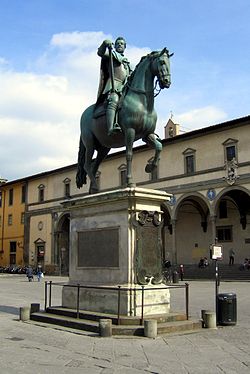Ferdinand I de' Medici
Ferdinand I de' Medici (in Italian, Ferdinando I de' Medici; Florence, July 30, 1549-Florence, February 3, 1609) was the third Grand Duke of Tuscany between 1587 and 1609. Fifth son of Duke Cosme I de' Medici and Leonor Álvarez de Toledo y Osorio, he was ordained a cardinal in 1562, at the age of fourteen. He built the Villa Medici in Rome, acquiring many works of art which he moved to Florence on his return.He succeeded his brother, Francis I de' Medici, as grand duke in 1587, aged thirty-eight.
Biography
Ferdinand I de' Medici was a capable administrator, as he had already demonstrated in Rome. He retained the cardinalship after being named Grand Duke, until his marriage to Cristina de Lorraine in 1589. On his death in 1609, he left behind four children, the eldest of whom, Cosimo, inherited the ducal throne at the age of nineteen.. Ferdinand's daughter, Claudia de' Medici (1604-1666) married the Duke of Urbino, Federico Ubaldo della Rovere.
Accessible and generous, he set out to rule leniently, restoring the judicial system and sincerely caring for the well-being of his subjects. During his government, Tuscany was resurrected and regained the independence lost during the government of his brother.
Ferdinand encouraged trade and obtained great wealth through the Medici banks, which were present in the largest cities in Europe. He issued an edict of tolerance towards Jews and heretics, so that Livorno became a port of welcome for Sephardic Jews, expelled from the Iberian Peninsula in 1492, as well as for other persecuted foreigners.
He improved the port of Livorno that his father had built, while diverting part of the course of the Arno River into a canal called the Naviglio, through which he boosted trade between Florence and Pisa. He promoted an irrigation project in the Val di Chiana, which allowed the plains around Pisa and Fucecchio to be cultivated, as well as in the Valle di Nievole.
Regarding his foreign policy, he tried to liberate Tuscany from Spanish domination. After the assassination of King Henry III of France, in 1589, he supported the future Henry IV of France in his disputes with the Catholic League. Fernando lent Enrique money and told him to convert to Catholicism, which he eventually did. Fernando also used his influence with the Pope to convince him to accept Enrique's conversion.
Enrique did not show much appreciation after these favors, so his relationship with Fernando cooled, the latter making an effort to maintain his valued independence. He supported King Philip II of Spain in his Algerian campaign, and the Holy Roman Empire against the threat of the Ottoman Empire. To undertake these companies he believed it necessary to raise taxes on his subjects. He finally obtained official recognition of his possession of Siena, which his father had conquered.
He also strengthened the Tuscan fleet, witnessing major victories over Berber pirates (1607), and defeating a superior Ottoman fleet the following year.
On his death he was succeeded by his eldest son, Cosimo, who ruled as Cosimo II de' Medici.
Colonial attempt
Ferdinand I made the only Italian attempt to create colonies in America. To do this, the Grand Duke organized an expedition to the north of Brazil in 1608, under the command of the English captain Thornton.
Nei primi anni del Seicento Ferdinando I di Toscana valuta la possibilità di una Colonia brasiliana.Ferdinando fa armre una caravella e una tarna nel porto di Livorno e le affida al capitano Thornton.In the early years of the seventeenth century Fernando I of Tuscany considers the possibility of making a colony in Brazil...Fernando prepares a "carabela" and a "tartana" in the port of Livorno and assigns them to Captain Tornton.
Unfortunately Thornton, on his return from the preparatory voyage in 1609 (he had been in the Amazon River), found Ferdinand I dead and his successor, Cosimo II, abandoned the project.
Offspring
| Name | Birth | Death | References |
|---|---|---|---|
| Cosme II | 12 May 1590 | 28 February 1621 | He married the Archduke Mary Magdalene of Austria, the sister of Emperor Ferdinand II of the Holy Roman German Empire. |
| Leonor | 10 November 1591 | 22 November 1617 | She was single. |
| Catalina | 2 May 1593 | 17 April 1629 | He married Fernando Gonzaga, Duke of Mantua. |
| Francisco | 14 May 1594 | 17 May 1614 | He remained single. |
| Carlos | 19 March 1595 | 17 June 1666 | He was a cardinal. |
| Filippino | 9 April 1598 | 3 April 1602 | |
| Lorenzo | 1 August 1599 | 15 November 1648 | He remained single. |
| Mary Magdalene | 29 June 1600 | 28 December 1633 | Born deforme, he spent his life in a monastery. |
| Claudia | 4 June 1604 | 25 December 1648 | He married Federico Ubaldo della Rovere, Duke of Urbino and, in second nupcias, the Archduke Leopoldo V of Habsburg. |
Ancestry
| Fernando I of Tuscany | Father: Cosme I de Médici | Paternal grandfather: Juan de Médici | Good-bye. Juan de Pierfrancesco de Médici |
| Paternal bisabuela: Catalina Sforza | |||
| Grandma paternal: María Salviati | Good-bye. James Salviati | ||
| Paternal bisabuela: Lucrecia de Lorenzo de Médici | |||
| Mother: Leonor Alvarez of Toledo and Osorio | Mother's grandfather: Pedro Alvarez de Toledo y Zúñiga | Maternal great-grandfather: Fadrique Alvarez de Toledo and Enríquez | |
| Maternal bisabuela: Isabel de Zúñiga | |||
| Maternal grandmother: Maria Osorio Pimentel | Maternal great-grandfather: Luis Pimentel and Pacheco | ||
| Maternal bisabuela: Juana Osorio and Bazán |
Contenido relacionado
Politics of Afghanistan
Church of rome
Anne Boleyn



